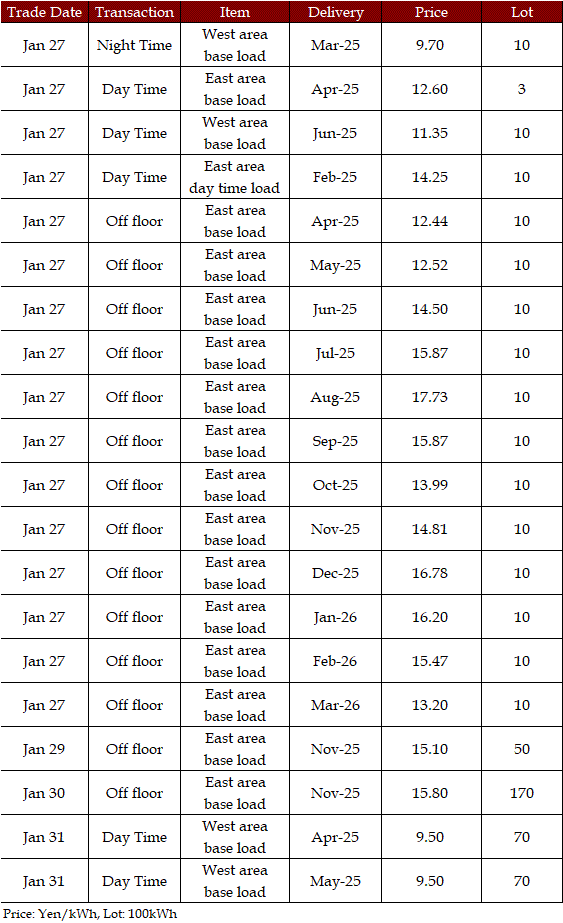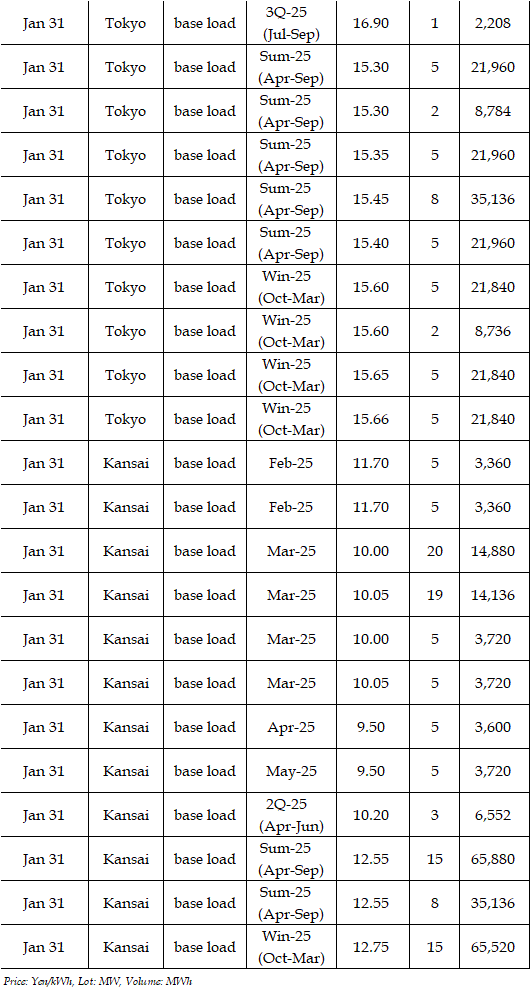|
In the day-ahead market on JEPX (Japan Electric Power Exchange), the 24-hour spot power prices on a weekly average basis for Jan 27-31 delivery remained almost intact from the previous week in East Japan (50Hz), but bounced back in West Japan (60Hz). West Japan attracted brisk spot buying as the temperatures dropped from the previous week in broad areas. The highest temperature in Osaka hovered in the range of 12-15 degrees for the week starting Jan 20, but fell below 10 degrees for the week starting Jan 27. But many players recognized the overall prices "just moved in a limited range" with limited upside potential.
In Tokyo and Kansai, the key areas in East Japan and West Japan, the 24-hour average posted a difference in favor of the East by Yen 2.50 for Jan 27 delivery, Yen 2.64 for Jan 28 delivery, Yen 1.21 for Jan 29 delivery, and Yen 0.19 for Jan 30 delivery. Kansai outperformed Tokyo by Yen 0.09 for Jan 31 delivery.
The fuel market trends in the final week of January were detailed as follows.
DES Northeast Asia spot LNG prices hovered in the mid $14 level per mmBtu for prompt March 2025 arrival as of Jan 30, up about 25cts from the end of the previous week (Jan 24). LNG prices softened through the middle of the week as growing availability loosened up supply-demand fundamentals. But European natural gas prices stretched a rally in the latter half of the week, and the LNG market in Northeast Asia followed suit. The Ministry of Economy, Trade and Industry (METI) announced on Jan 29 that Japan's LNG inventories for power generation stood at 2.15 mil mt as of Jan 26, down 160,000mt from a week before. The figure was steady from 2.15 mil mt as of end-January last year and up from the average of past five years at 1.96 mil mt.
FOB Newcastle thermal coal prices in Australia stood in the high $116 level per ton for February 2025 loading as of Jan 30. The level was down about $1.50 from the end of the previous week. Coal prices mirrored a downward trend in crude oil prices after the inauguration of US President Donald Trump.
In the crude oil market, WTI crude for March 2025 stood in the mid $73 level per barrel as of the morning on Jan 31 while Brent crude for March 2025 was trading in the mid $77 level. Both WTI and Brent were down more than $1 from with the end of the previous week. Crude oil prices came under pressure from a decline in US equity prices, combined with a larger-than-expected buildup in US crude oil inventories.
The actual highest price during the week was at Yen 17.99 in eight areas excluding Shikoku for Jan 30 delivery. Meanwhile, the actual lowest price during the week was at Yen 0.01 in Shikoku for Jan 30 delivery and Kyushu for Jan 31 delivery.
By area, the weekly average of the 24-hour spot prices was at Yen 13.55 in Hokkaido, down Yen 0.41 from the previous week, Yen 13.24 in Tohoku, down Yen 0.09, Yen 13.48 in Tokyo, up Yen 0.02, Yen 13.55 in Chubu, up Yen 0.58, Yen 12.84 in Hokuriku, up Yen 2.79, Yen 12.79 in Kansai, up Yen 2.75, Yen 12.60 in Chugoku, up Yen 2.56, Yen 10.41 in Shikoku, up Yen 1.82, and Yen 12.23 in Kyushu, up Yen 2.31.
In the JEPX auction, volumes of offers were 1,277.43 mil kWh on a weekly average basis, down 3.3% from the previous week. Meanwhile, bids on a weekly average basis expanded by 9.2% to 1,046.19 mil kWh. The weekly average of trade volumes grew by 5.8% to 853.71 mil kWh.
Power demand in nine areas of Japan during Jan 27-31 was a combined 13,975.22 mil kWh, up 5.4% from 13,260.68 mil kWh during Jan 20-24. The figure was up 2.9% from the corresponding period a year earlier. Demand during Jan 29-Feb 2, 2024 after day of week adjustment was 13,578.92 mil kWh.
Deals reported on TOCOM (Tokyo Commodity Exchange) during Jan 27-31 were as below.

Deals reported on EEX (European Energy Exchange) during Jan 27-31 were as below.









In the first week of February, spot prices are likely to turn stronger toward the latter half of the week. At the beginning of the week, the temperatures are forecast to be relatively high mainly in West Japan. But chilly climate will set in across Japan from the middle of the week, and heating demand is expected to pick up. Thus, growing demand is believed to lift spot prices. Meanwhile, the weather is forecast to remain cloudy broadly on the Japan Sea side. On the Pacific Ocean side, sunshine will be available mostly during the week. As a result, solar power supply can be expected to some extent, a factor that will likely put a lid on day time prices. Citing the price outlook, a source at a power producer and supplier said, "I believe the market will not change dramatically from the final week of January. But colder temperatures are likely to push up the 24-hour average around Yen 15 in both East Japan and West Japan."
|
JEPX: System Price (Day Ahead 24 hours)
|
|
Weekday Price
|
27-Jan
|
28-Jan
|
29-Jan
|
30-Jan
|
31-Jan
|
|
24-Hour Ave
|
11.80
|
12.20
|
12.65
|
12.95
|
13.30
|
|
Volume (MWh)
|
811,107
|
843,774
|
855,476
|
881,911
|
876,268
|
|
(unit: yen per kWh) (date: delivery day)
|
|
|

|